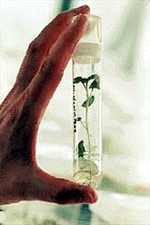 A report by Testbiotech e.V.
A report by Testbiotech e.V.
Institute for Independent Impact Assessment in Biotechnology
Christoph Then, Christoph Potthof
October 2009
SUMMARY
This is a report on the risk assessment procedure for genetically engineered plants in the EU. It reveals substantial flaws and loopholes in the procedure and practice of the institutions concerned. Many of the flaws have their origin in the European Food Safety Authority’s (EFSA) own main concept of risk assessment. This is essentially based upon guidelines that were developed by the OECD as early as 1993 on the assumption that the risks posed by genetically engineered plants are basically the same as those posed by conventional plants. This approach has admittedly been revised several times since 1993 but has in essence remained unchanged.
The report shows that the current guidelines are inadequate for sound risk assessment. New findings in genome research have in recent years transformed ideas of gene regulation and gene function. It has become evident that invasive intervention in genetic makeup and the transfer of isolated genes cannot be equated with natural mechanisms of heredity and gene regulation. The basic difference between conventional cultivation and genetic engineering of plants is becoming more and more distinct in the light of current genome research. Experience gained from cultivating conventional plants cannot – or only to a very limited extent – be applied to genetically engineered plants.
Even in conventional cultivation there are many changes in the genome but these do not break through the natural system of gene regulation. In contrast a new metabolism is forced upon genetically engineered plants. In fact the regularly observed changes in the activity of plant genes in this process are not an expression of natural gene regulation but an indication of disruption. These transgenic plants1 are technically manipulated products and as such much be assessed unconditionally for constructional flaws, quality defects and risks.
The outdated basic concept of the OECD from 1993 and the subsequent concepts developed for risk assessment of genetically engineered plants (FAO/WHO, 2000; Codex Alimentarius, 2003; EFSA, 2006) mean that the safety, predictability and controllability of genetically engineered plants are not examined in detail within the framework of approval procedure.
Irradiated food, pesticides, chemicals and medicines are all unconditionally tested for possible risks. In order to thoroughly test genetically engineered plants, however, there first of all has to be some proof that there may be a risk. Genetically engineered (GE) plants are deemed to be safe as long as no proof to the contrary has been produced. This means that GE plants are tested much more superficially than irradiated food, pesticides, chemicals and medicines.
Overall the concept as defined by the EFSA (2006, 2007a, 2007b) does not meet the requirements of the EU for comprehensive testing. It replaces actual risk testing by a system of presupposed assumptions based upon conclusions that are hardly verifiable.
In this report the authors give an overview of the reasons for recent doubts about the safety of genetically engineered plants and present different examples which show the inconsistencies and failures in EFSA’s risk assessment. One of the examples used to expose the lack of essential requirements for well-founded risk assessment is MON 810 maize which produces the Bt insecticide.
It is also extremely problematic that more and more cases are being documented showing that independent risk research is being hampered. In many cases it is not even possible to access necessary testing materials. Even the publication of findings is being obstructed. All in all the influence of industrial interests in research and the presentation of findings have reached alarming proportions.
Against the backdrop of various political discussions on the further development of testing standards in the EU, the authors make concrete suggestions on how testing systems can be improved to generate more data on the quality and safety of genetically engineered plants. They advocate more extensive testing on the compounds and genetic stability of GE plants before they are released into the field and companies can apply for market authorisation.
The plants should be subjected to a suitable level of exposure in specific “crash tests” to test their reaction to changing and extreme environmental conditions. Before field release and in order to collect more data on potential risk they should be tested (i.a. with different microorganisms) in a contained system to detect any interaction between the plants and a simulated environment. The authors suggest that these tests be introduced in the course of introducing improved step by step, case by case tests which have clearly defined test criteria for genetically engineered plants; with concomitant stronger collaboration between the authorities of member states and EU authorities and a higher consideration of ethical and socio-economic factors. The documentation of relevant information shall become a precondition for EU authorisation procedures.
Society, politics and approval boards should no longer close their eyes to the fact that agro-gene technology uses methods that are largely outdated and whose risk potential is higher than originally thought. It is not the fear of new products that make a critical appraisal of agro-gene technology necessary, but rather the fact that its scientific principles have been called more and more into question by new findings.
___________
[1] In this report no distinction is made between transgenic and so called cisgenic plants, because both are the result of transferring isolated gene sequences.
Full Report (pdf)






Claims of no human health effects by GM crops doesn’t match exisant facts.
In 2002 when it was finally noticed that pollen drift had contaminated all north american corn stocks with bt variaties-most unstable unapproved and unmarkered and so not responsive to the official tests-
The only approved for hog feed variety-starlink was being withdrawn for toxic effects on the hogs it was being fed to.
When medical researchers actually wish to learn what is happening,the first animal model they reach for is -Hogs.Not rats or monkeys.It is inconsievable that the severe reactions that adventis had reported as’enhanced weight gain’,chronic joint and organ inflamation;wouldn’t be produced in people eating the contaminated corn stocks.
yes, the dangers of GMO food keep surfacing in report after report. I keep thinking, we humans evolved with food and bugs, not with chemicals and bioballistics. This GM science is for another planet. It needs to be criminalized.